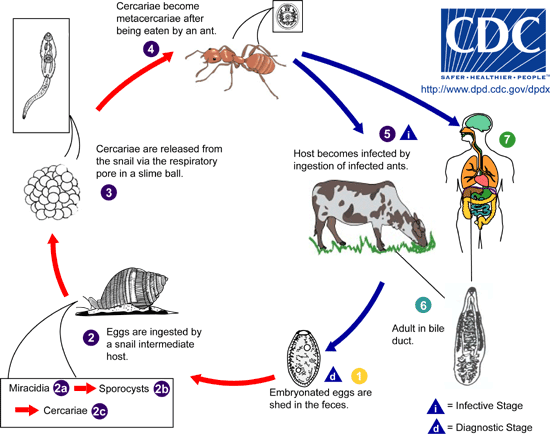Introduction to Diagnostic Medical Parasitology
Essentials
Dicrocoeliasis is a liver disease of animals (goat, sheep, cow) and less frequently of humans. It is caused by the small trematode Dicrocoelium dendriticum. the adult flukes live in the bile duct.

Undeveloped eggs are excreted with the feces. When a terrestrial lung-bearing snail consumes the infected feces, the development of the miracidium begins in this first intermediate host. Inside this snail, development and multiplication occur, leading to the release of cercariae through the snail's respiratory opening. A second intermediate host, an ant, ingests these slimy cysts containing the cercariae of Dicrocoelium dendriticum. Inside the ant, the cercariae develop into metacercariae. Once the metacercariae have matured, the ant travels to the tips of plants and firmly attaches there. The final host becomes infected when it consumes these plants with the attached ants.
Epidemiology
- The distribution is determined by the dry habitat of the first intermediate host
- Dicrocoeliosis is widespread
- Primarily in Central Europe (Switzerland, Southern Germany, Austria), but also in North Africa, North America, and Asia
- Mainly single human cases and some epidemics have been reported in the past
Pathology
- Pathology is correlated with the worm load; light infections cause no pathology
- Dicrocoeliosis is significant for veterinarians
- In contrast to the large liver fluke (Fasciola hepatica), tissue damage is less severe due to the absence of liver migration.
- In cases of heavy infestation, infected animals can become ill (loss of appetite, emaciation) and even die
Clinical Findings
- In rare cases, infections with Dicrocoelium dendriticum can be observed in humans
- These typically occur through the oral ingestion of infected ants
- An infestation leads to symptoms of cholangitis
Diagnosis
Parasitological methods
Diagnosis is based on finding eggs in stools .
Passage of eggs can be detected temporarily after a meal with infected liver!
The diagnosis can be confined by serodiagnostic tests when available.
Prevention and control
- Check food items, especially those that could potentially harbor ants, for signs of contamination or pests before consuming them.